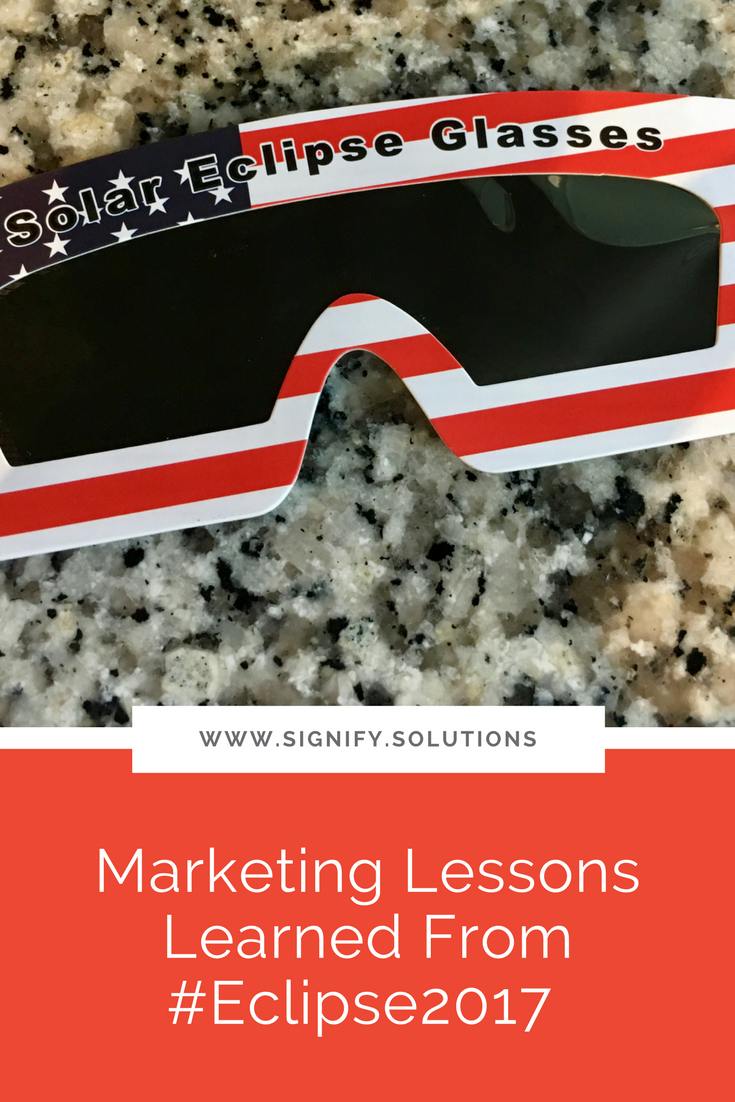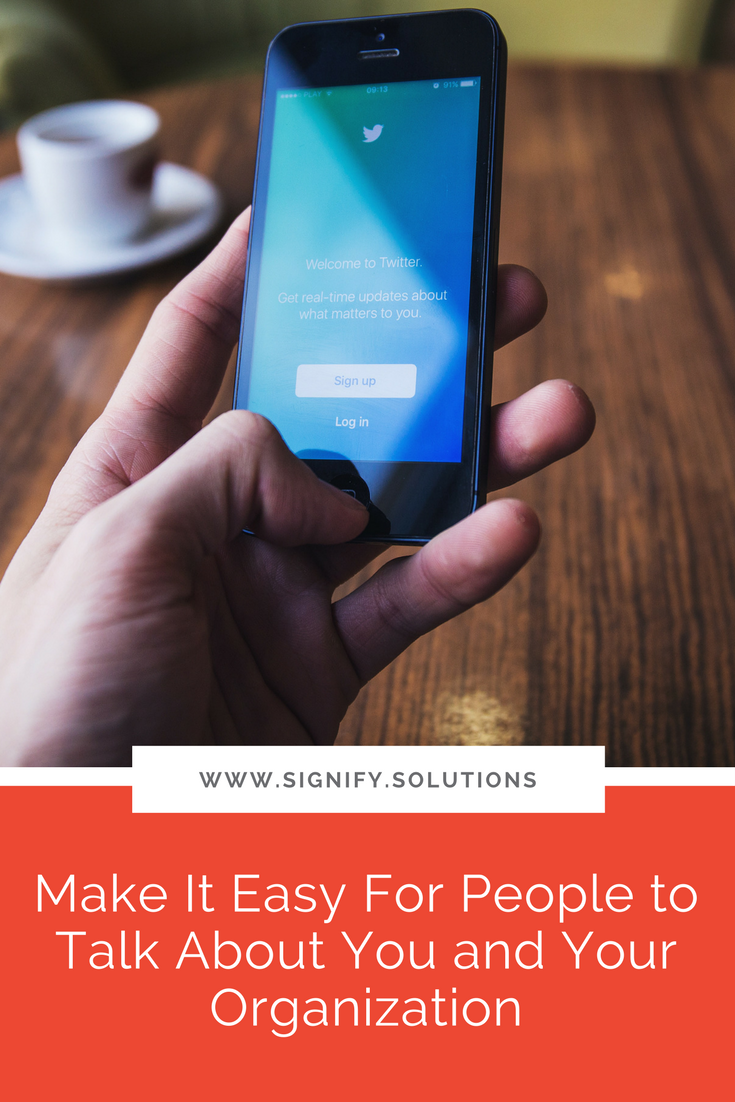I don't know about where you live, but Atlanta had #Eclipse2017 fever for weeks—and we weren't even in the path of totality, where the sun would be completely blocked by the moon. But there were apps, websites, news coverage, and huge shortages on ISO-certified glasses everywhere you looked. It was a fun frenzy to be a part of, honestly. I was totally into it. However, even after anticipating it for a couple of months, I still found myself unprepared. In the end, I had a great time, but it was also a tad chaotic.
And it was easy to make a few parallels between this unique experience and the world of marketing. So, be a business nerd with me for a minute, and just go with it . . .
1. Plan Ahead
Did you get your circa Back to the Future ISO-certified eclipse glasses? I almost didn't. I literally got my hands on a pair less than 40 minutes before the big event. I had been thinking about this moment for weeks and weeks leading up to it, but kept forgetting to pick up free glasses or buy them, and then when I put some real effort into it just a few days prior, they were, of course all gone. Like, long gone. My friend and I managed to buy a pair from a guy who's friend didn't show up to watch with him. Whew!
Marketing lesson: Good marketing doesn't just happen. If you don't live in the world of business communications as I do, there are plenty of other things to occupy your mind and your time. Believe it or not, sometimes it's even hard for me to make the time. And if you don't consider it to be one of your skills, it's easy to let marketing slide or get pushed to the back burner. But you can't expect people to buy, donate, or show up without some real effort on your part. I know there is already a lot on your plate, but stop and think about your marketing. Put together a plan, even a loose one to work from. Read a book, listen to a podcast, or get on an email list that will teach you more about marketing. The better you get, the more your organization will thrive.
2. Have a Backup Plan
I ended up enacting Plan D for my eclipse experience. Plan A was to win one of the cool trips I'd registered for, which would've meant watching it in either Portland or Nashville. Long shot? Absolutely, but how fun would it have been! Plan B was to buy glasses and go watch with my friend at her house because her daughter was napping and she couldn't get out. But I couldn't find any to buy because I waited too long. Plan C was to go to a local event that had glasses for sale. This is what I thought was happening up until it didn't. Another friend came with me to this event, but when we arrived, they'd already sold out of specs. That's when Plan D evolved.
We were standing in line for this event, but we didn't know if the line was for drinks, or to buy the glasses. So, I tapped the guy in front of me on the shoulder and asked. He said it was for drinks, and that they'd already run out of glasses. Gahhh! But he said that his friend didn't show up and that he'd sell us his extra pair! So, we grabbed those because it was almost 2:00 p.m., and the eclipse was happening at 2:36 p.m. here. We'd just have to share.
Marketing lesson: Maybe not every time, but at some point, something in your marketing plan will go wrong. (My experience is that it's usually technology-related.) Maybe it's a bad wifi connection, a glitch with your email provider, an event speaker gets sick or misses their connecting flight, the product doesn't get shipped on time, or your computer crashes and you know you were supposed to, but you haven't backed it up in six months even though you got a notification to do so the day before. It could literally be anything. The point is to have a backup plan, or three. Expect that something will go wrong, because it easily could. And do a happy dance when it doesn't!
3. Share the Experience
As you've already seen, I didn't plan very well for this historic moment. It wasn't until last Thursday when I actually started hunting for glasses. And I was sick last week and over the weekend, so even though I'd been excited for the eclipse, my enthusiasm was quickly waning. It wasn't until Sunday that I reached out to my friend to attend the viewing party with me. She showed some interest, but we didn't even make firm plans until around 11:00 a.m. on Monday!
I woke up that day still feeling pretty drained from being sick, so I'd almost resigned myself to just watching the eclipse on TV from my couch. I was about to text her that I wasn't feeling up to it, when she reached out to see if we were still on. So, I took a moment, remembered that previous excitement, and put together a plan. We ended up having a great time, and a fun, shared experience.
Marketing lesson: If you are a solopreneur or run a small business of just a few folks, it's very easy to get used to doing things on your own. This may be because it's just easier, you don't have the resources to pay others, or have a hard time delegating. But whether you're in the middle of a launch, promoting an event, fulfilling a product order, administering a service, or just dreaming of what's next, it's always more fun with a buddy. Conversations with others may give you new ideas, good feedback, inspiration, or one of another dozen awesome things. Even as a solopreneur, doing everything alone is a choice. Make plans to involve others, even informally. Your organization will be better for it. After all, you got in this business to help others. So, let someone help you.
4. Make It Last
If you're anything like me, your post-eclipse routine included updating social media with the photos you took. After that, I scoured Instagram and Facebook to see the photos and videos my friends and family captured. It was an experience worth sharing and celebrating. I also had friends that were in prime viewing spots all over the country, so I couldn't wait to see a glimpse of what they saw. It was truly an event that brought the country together, and gave us something fun to focus on after all the bad news we hear every day. I'll certainly be watching for those photos and videos in the days to come.
Marketing lesson: One of the common mistakes I see by organizations is that they host an awesome event, but they only talk about it before-hand. They don't promote it much during, and rarely after. Those are two prime opportunities to get your audience excited about your next event. Likewise, if you put a lot of time and effort into a launch, but never update your peeps about how it went, you're missing the opportunity to keep them in the loop and tell them how important they were to it. Or, do you put a lot of work into writing blog posts, but never actually promote them? It's unlikely people will just sit around waiting with baited breath until your next post. You need to market it! I've heard that 20% of the effort you put into your blog post should be writing it, and the other 80% should be marketing it. Your words may be incredible, but if no one knows to read them, they won't be very effective. Go the extra mile. Make it count, and then make it last.
So, did you watch the eclipse? Where from? What did you think?
PIN THIS POST FOR LATER:
I'm Kristi Porter, and I started Signify to provide writing, consulting and strategy services to nonprofits and for-profit organizations with a social mission, primarily through copywriting, marketing, and business communications. I believe that cause-focused organizations like yours are the future of business. You're proof that companies can both make money and do good. And I'm here to help you get noticed and grow. When you succeed, we all win.














































